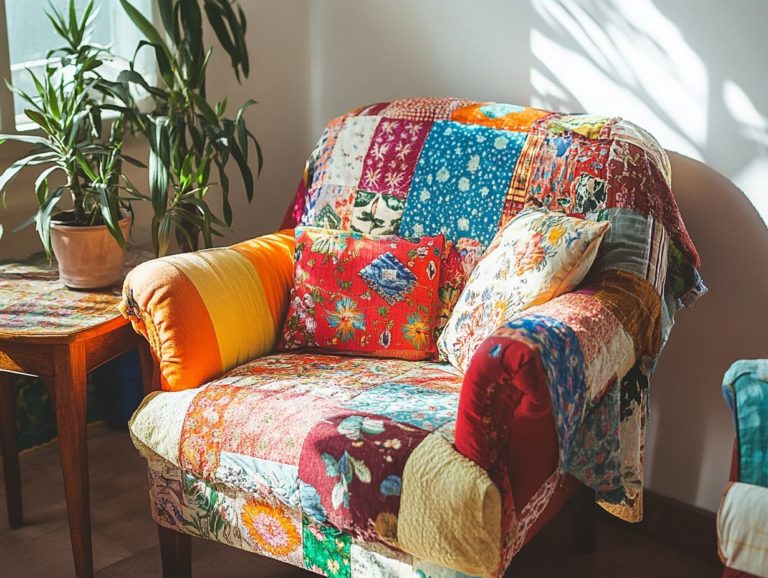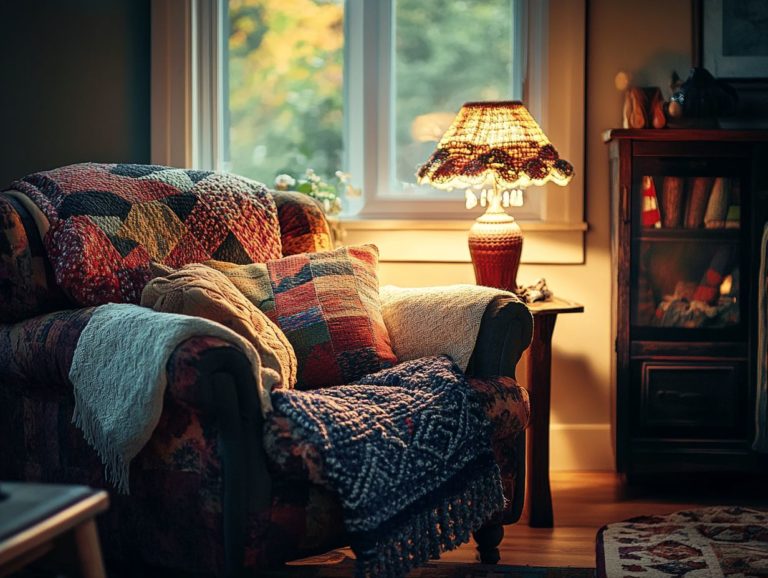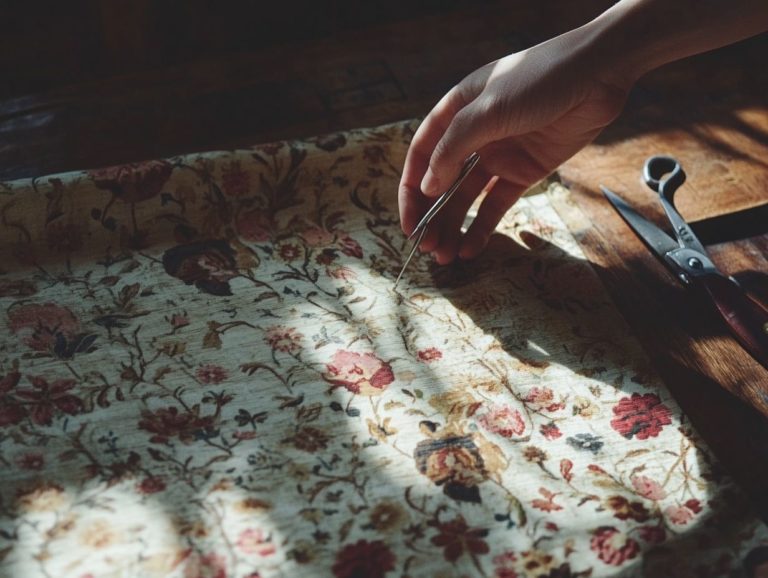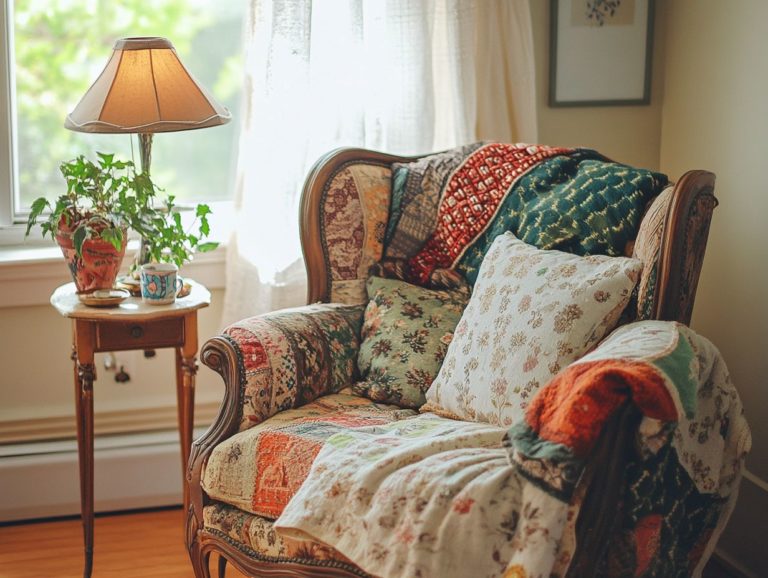The Beauty of Handwoven Vintage Fabrics
Handwoven vintage fabrics embody a rich tapestry of history, artistry, and craftsmanship that you can truly appreciate.
These textiles have ancient origins. Today, they capture contemporary admiration with their unique textures and patterns.
This exploration invites you to delve into the evolution of handweaving. It reveals the intricate processes and techniques that have shaped these fabrics over time.
Discover the many uses of these exquisite treasures! Learn how to care for them and see what makes them so special today.
Immerse yourself in the beauty and significance of handwoven vintage fabrics. Don t miss out on their captivating stories!
Contents
Key Takeaways:

- Discover the rich history and evolution of handwoven vintage fabrics.
- Explore the intricate process of handweaving.
- Appreciate the different types and patterns of handwoven vintage fabrics.
The History of Handwoven Vintage Fabrics
The history of handwoven vintage fabrics unfolds like a rich tapestry. It intertwines cultural heritage, traditional weaving practices, and the artistry of artisans from around the world.
From the ancient handloom techniques of the Indus Valley to the exquisite Chanderi silk of India, these fabrics narrate stories of craftsmanship, sustainability, and distinctive patterns. For those interested in learning more, understanding the value of vintage fabrics reveals why antique textiles have been cherished through the ages.
As you delve into the evolution of these textiles, uncover their significance in historical costumes and the vital support they provide to artisans. They play a crucial role in heritage conservation, underscoring the importance of honoring and preserving these treasured global textile traditions.
Origins and Evolution of Handweaving
The origins of handweaving can be traced back to ancient civilizations. Artisans honed intricate techniques to craft unique patterns that reflect their cultural heritage and artistry.
Across various regions, particularly in India, these time-honored methods have evolved over the centuries. They give rise to vibrant textiles that narrate the stories of their makers and the communities they represent.
From the opulent brocades (decorative fabrics) of Banaras to the refined ikat patterns (resist-dyed fabrics) of Odisha, the diversity and complexity of these weaves showcase not only technical prowess but also the deep-rooted traditions that accompany them.
However, the rise of fast fashion presents significant challenges to these ancient practices. It often overshadows the intrinsic value of handcrafted textiles. Therefore, preserving these historic weavings is crucial. We must ensure that both the artistry and the cultural narratives they embody continue to flourish in a rapidly changing world.
The Process of Handweaving
The art of handweaving requires careful attention to a meticulous blend of tools, techniques, and materials. Each element works in harmony, allowing you to create exquisite handwoven fabrics that celebrate the beauty of craftsmanship and embrace sustainability.
Tools, Techniques, and Materials
The essential tools and techniques in the handweaving process are truly remarkable. The handloom is critical for crafting breathable fabrics, along with various silk weaving methods that elevate both texture and design.
These handcrafted treasures often employ materials such as Chanderi silk and handspun cotton. Each contributes its unique charm to the fabric. Take Chanderi silk, for instance its lightweight and luxurious feel is achieved through a meticulous weaving technique that intertwines intricate patterns with vibrant colors, showcasing the artisan s skill and creativity.
On the other hand, handspun cotton offers a distinct texture. It is typically woven using more traditional methods that promote sustainability and support local artisans. This rich array of practices reflects cultural heritage and highlights the vital role of artisan support in preserving these invaluable crafts, as well as the benefits of using organic vintage fabrics.
Types of Handwoven Vintage Fabrics
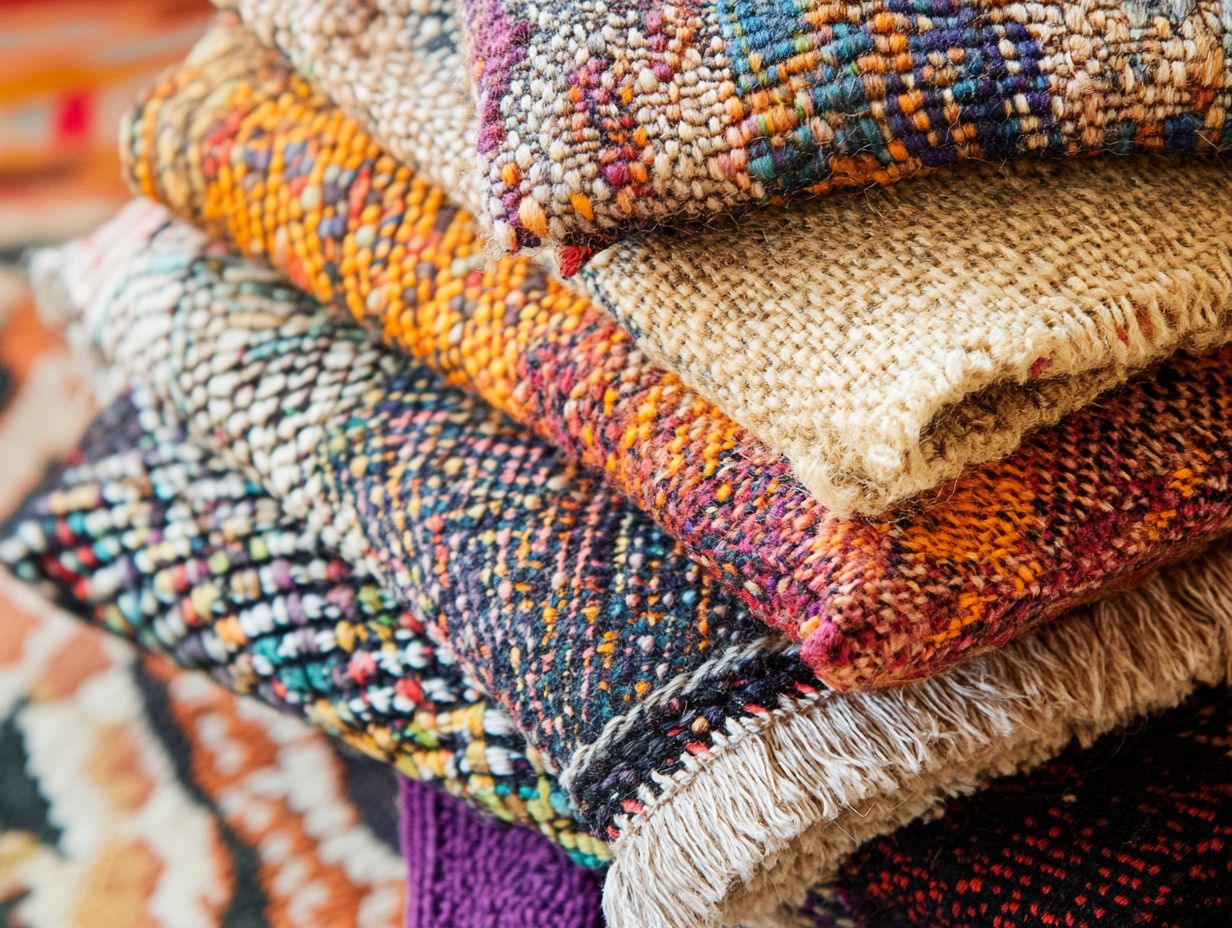
Handwoven vintage fabrics present an exquisite variety of types, each a testament to unique patterns and masterful craftsmanship that echo a rich tapestry of textile traditions.
From the timeless elegance of antique linen to the softness of cotton and the luxurious sheen of silk, these fabrics invite you to dive into their storied heritage.
Different Weaves and Patterns
The various weaves and patterns in handwoven fabrics not only enhance their visual appeal but also weave together stories of cultural heritage and craftsmanship, particularly in vintage clothing.
The allure of these weaves lies in their unique structures. Each offers a distinct visual and tactile experience. For instance, the plain weave creates a robust fabric that often serves as a foundation for more intricate patterns. In contrast, the twill weave features diagonal ribbing that enhances durability and introduces a distinct texture, adding depth to your garments.
Then there’s the luxurious satin weave, renowned for its smooth finish and glossy appearance; it often graces formal wear, enhancing the elegance of vintage pieces. These unique patterns do more than please the eye; they reflect the artisans’ skills and the cultural narratives embedded in the fabric, linking you to your heritage with every stitch. For those fascinated by these elements, exploring the timeless appeal of vintage textiles can offer deeper insights.
Uses of Handwoven Vintage Fabrics
Handwoven vintage fabrics exude a unique charm and versatility, serving as decorative elements and fulfilling functional roles. They pay homage to cultural heritage while championing sustainable practices across various applications.
Decorative and Functional Purposes
The decorative and functional uses of handwoven vintage fabrics shine through in home textiles, apparel, and accessories, seamlessly blending beauty with practicality while promoting sustainable fabrics.
Imagine vibrant throw pillows and intricately patterned table runners enhancing your living spaces, while practical items like unique jackets or chic scarves elevate your style. Each piece tells a story, reflecting the cultural heritage of the artisans who crafted them, embodying the essence of the revival of vintage fabrics in contemporary decor.
By opting for these fabrics, you actively contribute to sustainable practices, reducing waste and supporting traditional craftsmanship. The warmth and character these textiles bring can transform your environment, turning them into cherished items that harmoniously blend rich history with contemporary living. If you’re interested in sourcing these unique materials, discover where to find authentic vintage fabrics to enhance your collection.
Caring for Handwoven Vintage Fabrics
Caring for handwoven vintage fabrics requires keen attention to detail when it comes to cleaning and storage. By adopting the right methods, you can preserve their quality and ensure their longevity as sustainable fabrics.
How to Clean and Store These Fabrics
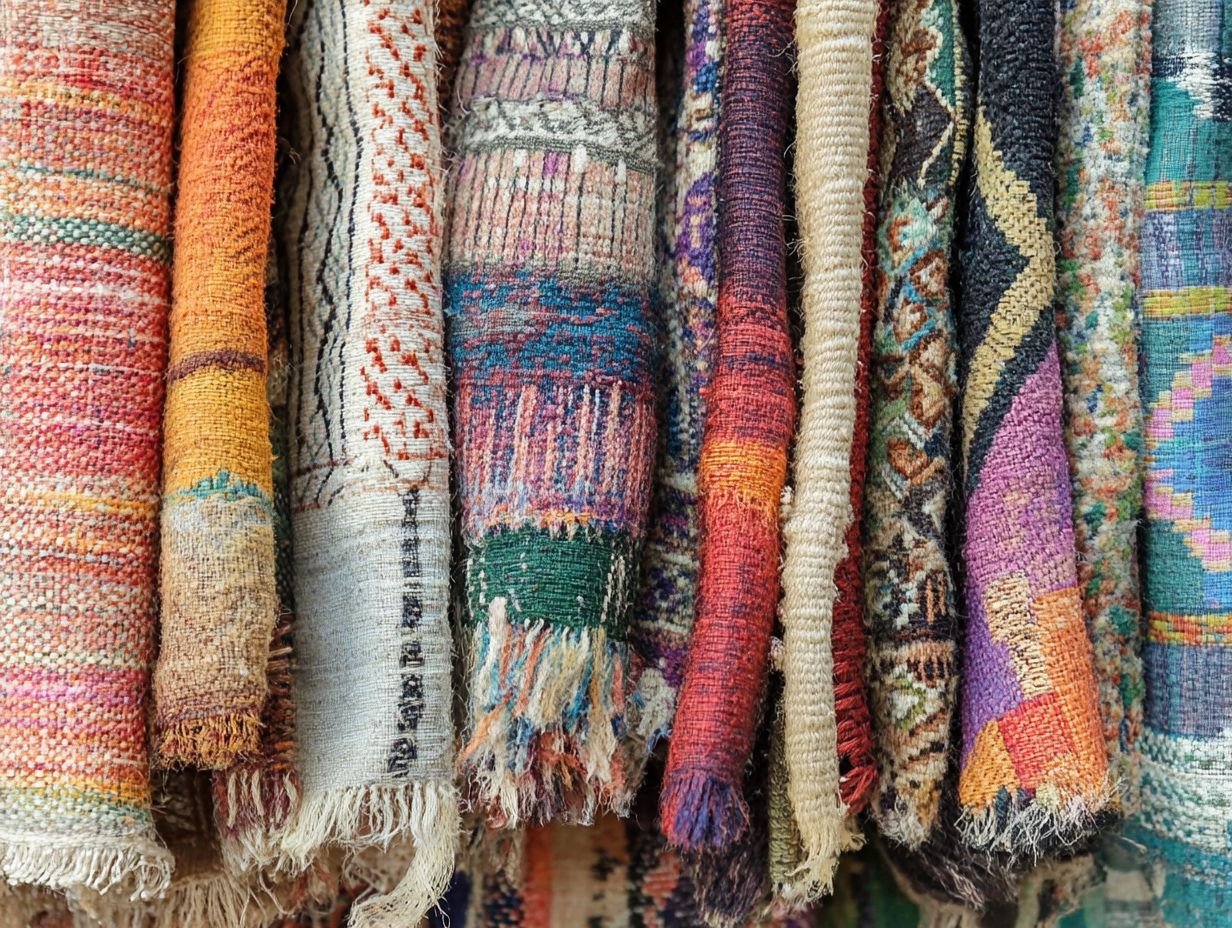
Proper cleaning and storage methods for your handwoven vintage fabrics, especially antique textiles, are key to preventing deterioration and ensuring their preservation over time.
When washing these unique pieces, use gentle, pH-neutral detergents these mild soaps won’t harm delicate fabrics. Hand washing in cool water is a great technique to maintain their vibrant colors and intricate designs. After cleaning, allow the fabrics to air-dry away from direct sunlight, as those pesky UV rays can cause fading and weaken the fibers.
For long-term storage, consider using acid-free tissue paper to protect the fabric’s structure. Place them in breathable cotton bags or acid-free boxes to help prevent moisture buildup.
By taking the time to care for these textiles, you’re not only extending their life but also honoring the artistry behind each handwoven creation.
Why Handwoven Vintage Fabrics are Special
Handwoven vintage fabrics truly capture attention with their distinctive qualities and characteristics. They celebrate cultural heritage, the craftsmanship behind each piece, and the artisan support that sustains their production.
Unique Qualities and Characteristics
The unique qualities and characteristics of handwoven vintage fabrics truly set them apart. You ll appreciate their intricate designs and commitment to sustainable materials.
Additionally, the skilled handmade work elevates these fabrics above mass-produced textiles. These fabrics offer excellent breathability, making them perfect for various climates. They allow your skin to breathe while still providing warmth.
The varied textures, shaped by methods used by skilled artisans to create fabric by hand, offer tactile experiences often lacking in mass-produced options.
Every stitch reflects a deep respect for heritage, ensuring that each piece carries its own distinct story. By choosing these fabrics, you embrace a unique aesthetic and support sustainable practices along with the artisans who dedicate their lives to preserving this ancient craft.
Frequently Asked Questions
What are handwoven vintage fabrics?
Handwoven vintage fabrics are textiles made by hand using traditional weaving techniques. They are typically crafted from natural fibers and have a unique, one-of-a-kind look.
What makes handwoven vintage fabrics beautiful?

The beauty of handwoven vintage fabrics lies in their imperfections. Each piece has a unique texture, color, and pattern that cannot be replicated by machines. They also carry a rich history and cultural significance.
Where can I find handwoven vintage fabrics?
- Specialty textile shops
- Antique stores
- Online marketplaces
- Local markets
- Independent weavers
How should I care for handwoven vintage fabrics?
Handwoven vintage fabrics should be treated with care to preserve their beauty. They should be hand washed in cold water with mild detergent and laid flat to dry. Avoid using bleach or harsh chemicals, as they can damage the fabric.
Can handwoven vintage fabrics be used for home decor?
Yes, handwoven vintage fabrics make beautiful and unique pieces of home decor. They can be used as wall hangings, table runners, pillow covers, and more. Their intricate patterns and textures add character and warmth to any space.
Are handwoven vintage fabrics sustainable?
Yes, handwoven vintage fabrics are considered sustainable as they are made from natural and renewable materials using traditional techniques. They also have a longer lifespan compared to mass-produced fabrics, reducing the need for constant replacements.
Discover the beauty and sustainability of these fabrics today!


